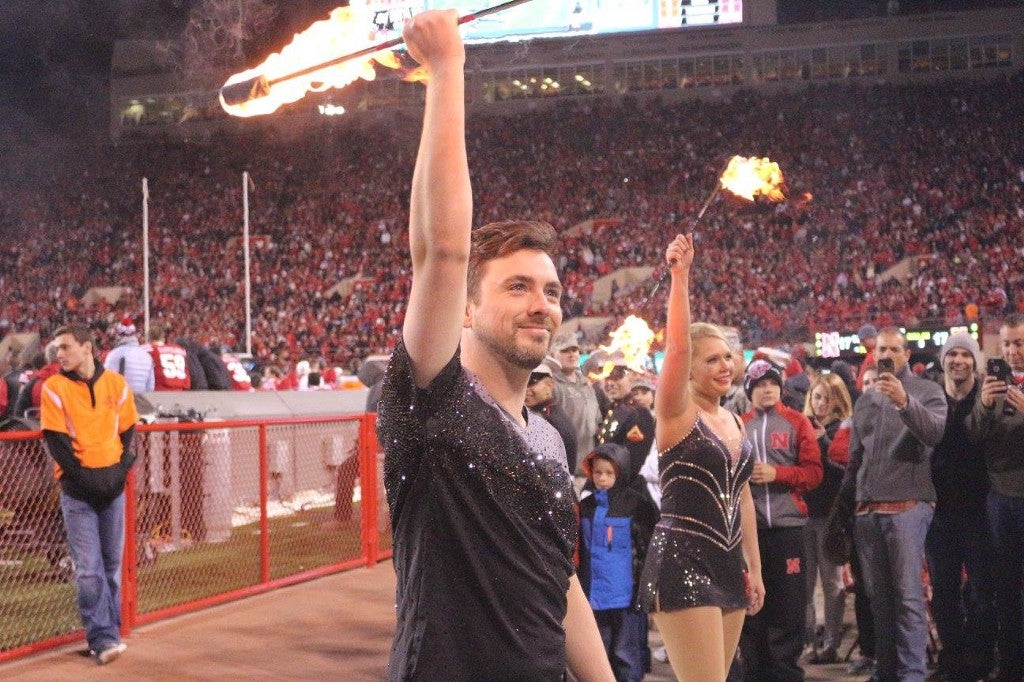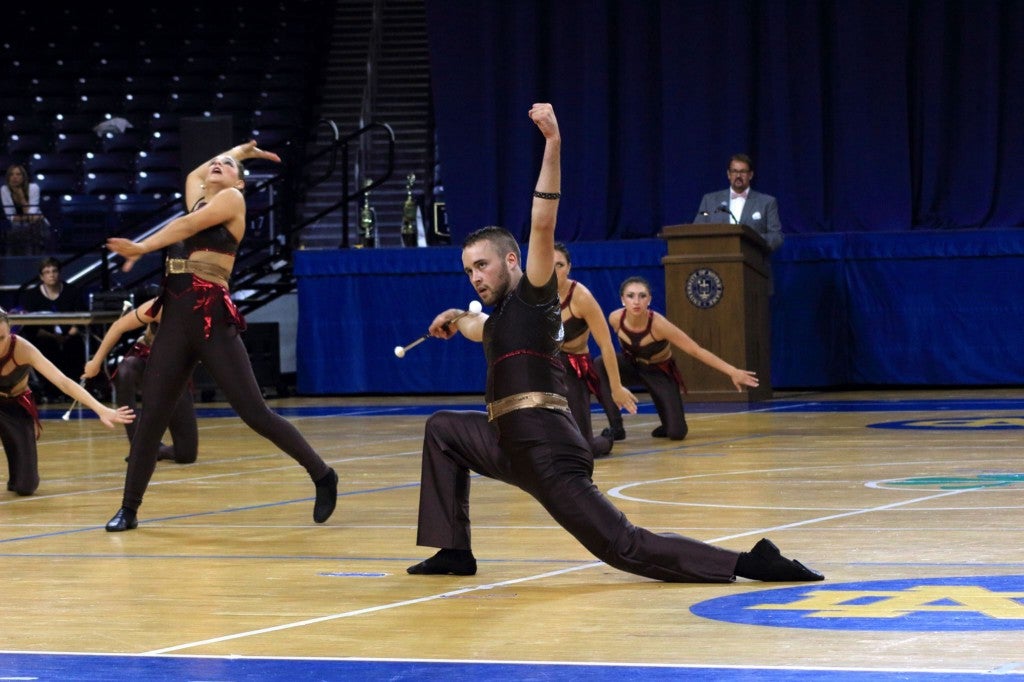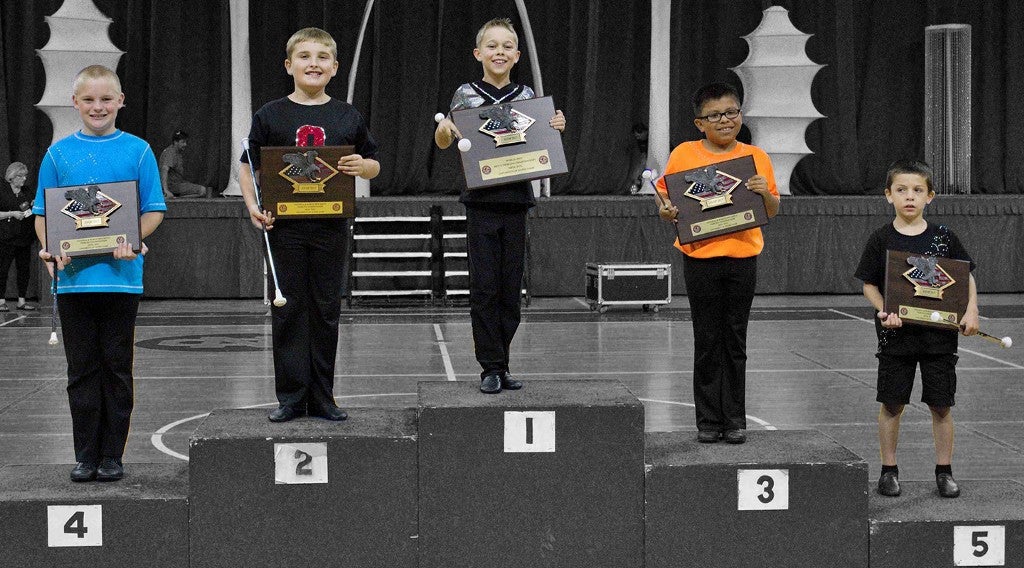Nine-year-old Ciaran Muir wears a V-neck top bedazzled with lime-green rhinestones while cartwheeling through a Scottish field and hurling a two-foot rod in the air. He sports calloused hands and six-pack abs, gained through countless hours of training in the physically demanding sport of baton twirling.
“I’m the only boy I know who does it,” Muir told the U.K. newspaper The Courier in mid-June. “It proves that baton is not just for girls, it’s also for boys.”
But it’s an unusual pursuit for boys, despite early baton-twirling contests in the 1930s and 1940s being dominated by men. When men went off to World War II, however, women moved in to fill the vacancies. While most of the jobs were eventually returned to men after the war ended, some activities — like cheerleading and baton twirling — remained predominantly female callings. In fact, after the late 1950s, men all but disappeared from baton twirling, which, in turn, only became more and more feminized throughout the 20th century via increased glitz, glamor and rhinestone outfits.

These days, fewer than one in 100 baton-twirlers are men, according to Trenton Haltom, a sociology Ph.D. student from the University of Nebraska who interviewed 30 male baton-twirlers — ranging in age from 19 to 74 — for his 2015 master’s thesis, “Experiencing the Blue Curtain: The Effects of Tokenism on Masculine Identities Among Male Baton-Twirlers.”
Haltom is also a competitive twirler himself. I spoke with him while he was at the National Baton Twirling Association’s championships, or the World Series of Baton Twirling as it’s commonly known. We talked about how male baton-twirlers are encouraged to perform to Metallica to play up the masculinity, how twirling stage dads make their sons train with lead pipes to enhance their wrist strength and how one male twirler in Haltom’s study likened the men who twirl to unicorns: “Rare, yet powerful.”

What do you think your respondent meant by the description “rare, yet powerful”?
Like unicorns, male baton-twirlers have become almost mythical creatures because most people don’t know they exist. They’re hidden until they appear out of the myst like magical things. People are like, “Boys can twirl?” So they’re rare numerically. But they’re also powerful because they’re challenging gender boundaries and doing something that only girls are known for these days — while simultaneously competing against them.
But men were once big-time twirlers, right? How did the sport originate as a masculine domain?
Twirling began with men in the military and became popular in the 1940s during World War II. Drum majors would spin maces — long staffs with a ball at the top. Over time, however, the mace evolved into a shorter, lighter baton with rubber instead of metal ends. Thus, it became easier to wield and would hurt less if it hit you in the head. But in terms of the sport’s gender switch, it’s a chicken-and-egg situation: Did women enter and then the baton developed, or did the technology of the baton improve allowing women to enter? I tend to think it’s the former.
Why are there so few men in the sport now?
Much like cheerleading, there’s a stigma against it. People remember going to football games and parades when they were younger and watching women twirling, so they’re wired to assume boys can’t do it. Also, since there are so many girls in the sport, it’s assumed the boys twirling must be gay. The event I’m currently attending at Notre Dame includes an “all-around competition” referred to as a “pageant” in which the (exclusively female) winner wins a crown and sash and is named “Miss Majorette of America.”
Did age have anything to do it with it? For instance, in your study, was it more accepted for male Baby Boomers to twirl?
Not necessarily. One 60-year-old man I interviewed grew up in a small town in the South and taught himself how to twirl. It wasn’t accepted so he tried to keep it under wraps. He felt that he had to be good — fast, effective and never drop the baton — in order to convince people that it was legit. A lot of the guys I talked to felt the same pressure. I call it the “I gotta show you” phenomenon.
You suggest that male baton-twirlers experience both male privilege and male disadvantage at the same time. How so?
In so many ways, men are privileged — they have better options at school and work, for example. But when you put men in these feminized spaces, some of that goes away. They still get some attention because they’re so unique, but at the same time, this isn’t their world. They’re cast aside in many ways. Men and boys who twirl often don’t get the same awards. Their events aren’t given the same prestige. It’s kind of a weird mix. It’s an interesting case where men may not completely lose their privilege but it’s certainly questioned. They think, I’m surrounded by a group of girls. I’m the center of attention because I’m the only male. But it doesn’t mean it’s my space to dominate.

Are male baton-twirlers encouraged to play up their masculinity in terms of the music they twirl to and what they wear?
It’s the twirlers’ option to choose their own music, so the boys will often twirl to Metallica or hard rock music. It’s usually a song with a male singer or masculine themes, like Phantom of the Opera. Superheroes are popular, too — I just watched a Batman routine at the [World Series of Twirling]. In terms of costuming, I saw a lot of black this year. They’ll often wear “masculine”-colored costumes accentuated with anything from a skull and crossbones to animals, stars, fire, lighting strikes and superhero emblems.
Men and boys haven’t been encouraged to enter female-dominated spaces while women seem to be increasingly entering male-dominated jobs like coaching in the NFL. Why do you think that is?
Women gain a lot more from entering male-dominated occupations because they can earn more. Whereas if men were to enter female-dominated occupations they lose out on wages because female occupations are often devalued. Also, men aren’t supposed to do caring occupations because caring for people is a motherly trait.
Is spinning a stick-like object a masculine skill celebrated in other cultures?
Yes. You have the Samoan fire spinners in Hawaii, flag-swinging in Switzerland and Italy, and Asian martial artists swinging bow staffs — and yes, men are typically swinging them.
Can you speak to the athleticism involved? Do most twirlers sport six-packs like Ciaran?
It’s a very athletic sport. You need to have a lot of shoulder and wrist strength. There are a lot of jumps involved, especially for the men, who are expected to be a little more athletic. We have a move that’s called an “illusion,” which kind of looks like a cartwheel while one legs stays on the floor. Like male figure skaters having to attempt more quad jumps, we’re pushed to do more spins.
Is that why men are automatically placed in the advanced difficulty division?
Some of it has to do with numbers. There aren’t enough men to make lower divisions. Typically, the average girl might go from novice to beginner to intermediate to advanced and need to have a certain amount of wins within each before moving up to the next level. The boys are automatically advanced, which in some ways is good because you have to learn more material. But you also have to learn more material. A new boy put in the advanced category may be twirling against someone who’s been twirling for 10 years. So they’re at a disadvantage that way.
What’s the significance of the “free hand”?
You twirl the baton using one hand, leaving the other one free. When boys are learning to twirl, they’re encouraged to make a fist with that hand because it’s manlier. One judge in my research described it as a “more physical look,” because you’re flexing when you make a fist and it makes the muscles pop out. Boys are supposed to be violent; they’re supposed to punch things. So coaches often add it to the routine. Sometimes they even have them punch toward the judges — not in a violent way but as a way to make masculine eye contact.

Overall, how well are male twirlers received in competition?
In terms of male college twirlers, most people are supportive and think it’s cool. I know someone who twirled at Penn State, and he was beloved and had autograph signings. On the other hand, I twirled at a bowl game at the University of Tennessee this past season and found people commenting on my twirling and making fun of me. While people may appreciate the skill, they still think of it as an effeminate thing that only girls are allowed to do.
A couple of the men in your study said they felt “vulnerable and unprotected” when they were learning how to twirl. How prevalent is bullying?
Younger boys are often made fun of and bullied because they’re holding a baton. Some of my participants talked about how they were shoved into lockers or had their lockers vandalized with profanity. One guy said he would hide his baton if he were going to a lesson after school. He didn’t want his peers to know. Twirling became a life-altering stigma for another guy who said it delayed him from growing up. He literally avoided going to college after high school and quit several jobs because he was recognized as a twirler.
One man in your study said his association with twirling was a “free burn card”? What does that mean?
Everyone felt they were permitted to make fun of him — from peers to teachers. He’d go home crying, wondering why. He actually started twirling because he liked a girl who twirled and wanted to be with all the girls. He talked about making out with them in the stairwells. But he had a really hard time with it as well. He took up wrestling his senior year in high school to reverse the stigma associated with it. He admits the irony of changing one spandex costume for another and leaping into a pile of sweaty boys.
Tell me about the twirling stage-dads you wrote about in your thesis.
One dad made his son lift weights and twirl heavy metal bars to strengthen his wrists. Another guy’s dad was a baseball player; yet another kid’s dad played basketball — both sports where you have these intense strength training sessions. They used that model and applied it to twirling. That said, the majority of the time, the dads weren’t supportive. They’d rather their sons played other sports. But boys usually found a way to do it behind their families’ back anyway.

Are there other examples of men joining feminized sports, extracurriculars and occupations?
Dance was also historically male-centered (thanks to King Louis XIV), but has become female-dominated over time and stigmatizing for men. Men in dance have to push their tricks like I mentioned above — more spins, bigger jumps, etc. There’s also a heteronormative feel to the dance world. Consider all the ballets where the prince and the princess are the center of the storyline — men have to become these princes. That’s why many effeminate men don’t become principal dancers and instead stay in the corps de ballet.
Other sports include rhythmic gymnastics, figure skating and anything with an essence of artistry involved. Occupations include teaching, social work, librarians, physical and therapists. Not to mention, there’s still some sex segregation in medical specialties: OB/GYN and family medicine (women) versus neurology (men).
Would you say, on the whole, that women have had an easier time entering men’s sports (boxing, UFC, football coaching, etc.)?
Yes, because they have more to gain and less to lose from entering men’s sports while the opposite is true for men entering women’s sports. There’s less stigma for women, and it’s often thought of as empowering for them to participate in these sports.

